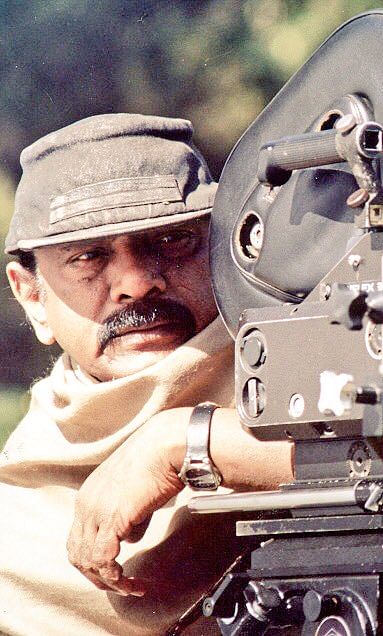Of all the film endings in Hindi cinema, Sadma’s is one of the most heartbreaking. A young Sridevi, recovered from her retrograde amnesia but now completely oblivious to the man she loved, who took care of her while she was ill, made even the most stone-hearted audience well up. The man to thank for this film, considered one of Hindi cinema’s finest, is Balanathan ‘Balu’ Mahendra.
Born on 20 May 1939 in Sri Lanka, Balu was a cinephile from a young age. The Tamil filmmaker was bitten by the film bug when he witnessed the shooting of 1957’s The Bridge on the River Kwai in Sri Lanka. He went on to study cinematography at the Film and Television Institute of India in Pune. He graduated the top of his class and caught the eye of Malayalam filmmaker Ramu Karyat, who asked Balu to assist him on the 1974 film Nellu.
From there, as they say, there was no looking back. “It was the best debut I could have hoped for; I had seen his (Kayat’s) movie ‘Chemmeen’ and was impressed. I was lucky that I could work with some of the finest directors in Malayalam cinema such as Karyat, P.N. Menon, K.S. Sethumadhavan and Bharathan,” he said.
On his birth anniversary, here is a look at Balu Mahendra’s cinematic legacy.
Also read: Satyajit Ray: Cine maestro & literary genius who could say no to Indira Gandhi, Narasimha Rao
Natural stories, natural lighting
Known for his revolutionary work in Tamil cinema, Balu worked as a cinematographer for many award-winning South Indian directors, such as Menon, Sethumadhavan, Bharathan, Mahendran, K Viswanath and Bapu, and shot Sankarabharanam (1980), which is one of the biggest blockbusters and an icon of South Indian cinema. He made his debut as director in 1977 with the Kannada film Kokila, which starred Kamal Hassan, for which he won a National Award.
The accolades poured in fast for Balu, who won countless state awards, Filmfare awards and six National Awards. Films like Olangal, Nireekshana, Yathra and Veedu attained critical as well as mass appreciation as he introduced a very different kind of film, one that challenged the mainstream.
An audience that was used to high drama was now given a taste of realistic storytelling that focused on the complexities of human relationships. He also traded the traditional bright lights and huge sets for natural light and locations that people could relate to.
Balu was inspired by other filmmakers like Satyajit Ray, David Lean and even juniors like Mani Ratnam. Ray’s Pather Panchali and Charulata were particular favourites that he would often turn to. “The impact was terrific and I could not concentrate on anything for days. It was as if I was possessed by a ghost,” he once said of Pather Panchali.
The effect of parallel cinema was clearly evident in his storytelling choices as well. Balu was also known for writing his own scripts, which were the main meat of his films. His debut Kokila tells the story of young love torn apart by indiscretion, while Olangal looks at how past mistakes can come back to haunt the happiest of people. Balu showed people real, raw stories of imperfect humans — something they could relate to.
Perhaps his most famous film, though, is Moondram Pirai (1982) which Balu remade in Hindi as Sadma, with the same cast. The film looks at an innocent, fragile love story between a woman suffering from retrograde amnesia and a caring man, and how, at the end, when she is declared cured, she not only doesn’t recognise him, but thinks he is insane. It was at once a message that some relationships, some loves cannot be defined, as it was a message about the stigma of mental illness. The film not only won him a National Award, but also shot Sridevi to national fame for her performance. It remains, to this day, acclaimed as one of the best pieces of cinema India has seen, and a milestone in her career.
Also read: Sona Mohapatra’s docu-film is her saying she won’t shut up, about her clothes, art, activism
The 1990s and the decline of Balu’s kind of filmmaking
The early ’90s saw the beginning of flashy cinema again, thus spelling a downward spiral for Balu’s films. He only made a handful of films in the ’90s and early 2000s, given the lack of reception and inspiration. In 2007, he set up a film school, Cinema Pattarai, in Chennai, where he took his true form as mentor and teacher. “It is more like a ‘gurukulam.’ I enjoy teaching cinema to my students. I make them watch several world classics and then discuss those films,” he said.
Balu Mahendra died on on 13 February 2014, following a heart attack. Even though he directed only 25 films, he will always be remembered for creating a different kind of cinema, starting a revolution and making a lasting impact on South Indian cinema.




As a freelance film critic in the seventies and eighties I had the opportunity to interview Balu Mahendra on several occasions. I have always found him to be full of beans and though there were accusing fingers pointed towards him for filching subjects from Hollywood movies his brand of cinema had many takers. Cinematography was child’s play for him and his frames in his films like ‘Moondram Pirai’ would reveal that he had mastered the craft. It is a fitting tribute to the late director ( who also wrote the screenplay and dialogues for the films that he helmed) that the top auteurs of today like Bala, Vetrimaran, Ameer, Seenu Ramaswamy all picked up the nuances of film direction by being his understudies.